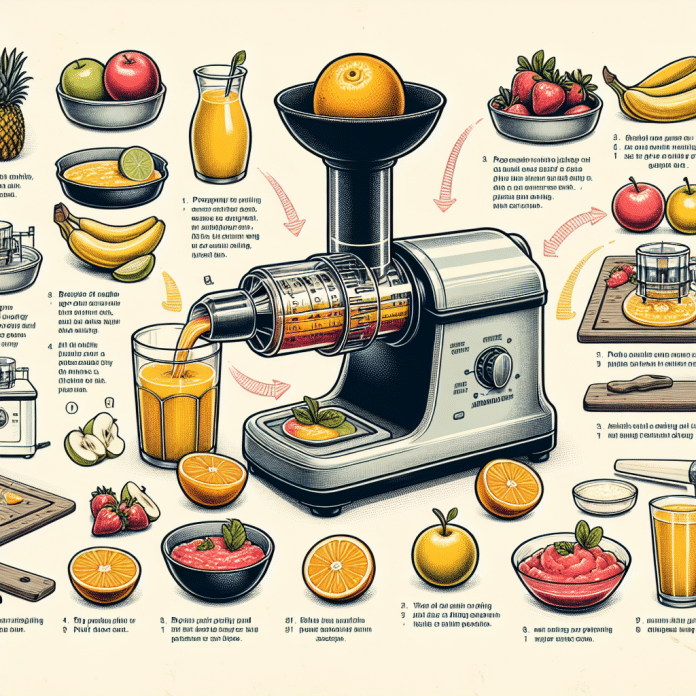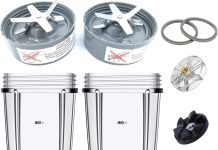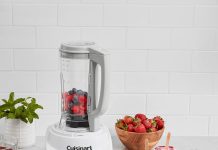Have you ever wondered if your masticating juicer can do more than just extract juice from fruits and vegetables? Well, you’re in for a treat! In this article, we will explore the possibility of using a masticating juicer to create delicious and refreshing fruit sorbets. Say goodbye to store-bought sorbets and hello to homemade frozen delights that are healthy and bursting with flavor. Let’s dive into the world of masticating juicers and discover the endless possibilities they offer for your culinary adventures. So, put on your apron and get ready to unleash your creativity in the kitchen!
Review contents
What Is a Masticating Juicer?
Definition and Function
A masticating juicer, also known as a slow juicer or a cold-press juicer, is a type of juicing machine that operates at a slower speed compared to centrifugal juicers. It uses a chewing or grinding motion to extract juice from fruits and vegetables. Unlike centrifugal juicers, which use high-speed spinning blades to quickly extract juice, masticating juicers crush and squeeze the produce to extract the juice. This slow and gentle process helps to preserve the nutrients, enzymes, and natural flavors of the fruits and vegetables.
Advantages of Using a Masticating Juicer
There are several advantages to using a masticating juicer. Firstly, the slow extraction process helps to retain more nutrients and enzymes in the juice. The low speed prevents heat buildup, which can damage delicate enzymes and nutrients. Additionally, the slow extraction process minimizes oxidation, which helps to maintain the vibrant colors and flavors of the juice.
Another advantage of using a masticating juicer is its versatility. In addition to extracting juice, masticating juicers can be used to make a variety of other healthy and delicious treats, such as fruit sorbets, nut milks, and even homemade pasta. The ability to perform multiple functions makes a masticating juicer a versatile and valuable addition to any kitchen.
Making Fruit Sorbets with a Masticating Juicer
Can a Masticating Juicer Make Sorbets?
Yes, a masticating juicer can indeed be used to make fruit sorbets. The slow and gentle juicing process of a masticating juicer helps to extract the juice from frozen fruits, creating a smooth and creamy sorbet-like texture.
How Does a Masticating Juicer Help in Making Sorbets?
A masticating juicer is particularly helpful in making sorbets because of its ability to juice frozen fruits. By juicing frozen fruits, the masticating juicer creates a frozen puree that can be enjoyed as a sorbet. The slow speed and chewing action of the masticating juicer efficiently process the frozen fruits, resulting in a smooth and creamy sorbet-like texture.
Choosing the Right Fruits for Sorbets
Types of Fruits Suitable for Sorbets
When it comes to making sorbets, it is important to choose fruits that have a high water content and are naturally sweet. Some popular fruit options for sorbets include berries (such as strawberries, raspberries, and blueberries), citrus fruits (such as lemons, oranges, and limes), tropical fruits (such as mangoes and pineapples), and stone fruits (such as peaches and apricots). These fruits not only provide a refreshing and vibrant flavor but also have a good texture for sorbet making.
Best Fruits for Masticating Juicers
While a masticating juicer can handle a wide variety of fruits, there are certain fruits that work exceptionally well in these machines. Fruits with softer textures, such as berries, bananas, and mangoes, are ideal for masticating juicers. These fruits easily break down during the slow juicing process, resulting in a smooth and velvety sorbet-like texture.
Preparing Fruits for Sorbet Making
Washing and Cleaning Fruits
Before preparing the fruits for sorbet making, it is essential to wash and clean them thoroughly. This helps to remove any dirt, debris, or pesticides that may be present on the surface of the fruits. Simply rinse the fruits under cold running water and gently scrub them with a soft brush to ensure they are clean and ready for consumption.
Peeling and Deseeding Fruits
In some cases, peeling and deseeding the fruits may be necessary, depending on the type of fruit being used. Citrus fruits, for example, should be peeled to remove the bitter white pith and any seeds. Stone fruits may also need to be peeled and pitted before juicing. However, for fruits like berries or grapes, there is no need to peel or deseed them, as the masticating juicer will efficiently process the entire fruit.
Cutting and Slicing Fruits
To ensure efficient juicing, it is recommended to cut larger fruits into smaller pieces before juicing. This helps to prevent clogging and ensures a smoother juicing process. For example, large fruits like mangoes or pineapples can be cut into chunks, while smaller fruits like berries can be juiced whole.
Freezing Fruits
To create the sorbet-like texture, it is crucial to freeze the fruits before juicing. Simply place the prepared fruits in a freezer-safe container or bag and freeze them until firm. Freezing the fruits not only helps to create the desired texture but also helps to preserve their freshness and flavor.
Using a Masticating Juicer to Make Fruit Sorbets
Step-by-Step Process of Making Sorbets
To make fruit sorbets using a masticating juicer, follow these simple steps:
- Prepare your chosen fruits by washing, peeling, deseeding, and cutting them into smaller pieces if necessary.
- Freeze the fruits until firm.
- Set up your masticating juicer according to the manufacturer’s instructions.
- Remove the frozen fruits from the freezer and allow them to thaw slightly for a few minutes.
- Feed the partially thawed fruits into the juicer’s feeding chute.
- Use the plunger to gently push the fruits through the juicer’s auger, applying steady pressure.
- Collect the frozen fruit puree that comes out of the juicer’s spout.
- Continue juicing the remaining fruits in the same manner.
- Once all the fruits have been juiced, mix the fruit puree thoroughly to ensure a consistent sorbet-like texture.
- Serve the freshly made fruit sorbet immediately or transfer it to a freezer-safe container and freeze for a firmer texture.
Juicing the Frozen Fruits
When juicing frozen fruits with a masticating juicer, it is important to allow them to thaw slightly before juicing. This helps to prevent excessive strain on the juicer’s motor and auger. Partially thawing the fruits also ensures a smoother and more efficient juicing process.
Mixing and Incorporating Ingredients
To enhance the flavor and texture of the fruit sorbet, you can incorporate other ingredients such as sweeteners or flavor enhancers. Natural sweeteners like honey, maple syrup, or agave syrup can be added to taste. Additionally, you can experiment with adding herbs, spices, or even a splash of citrus juice to enhance the flavors of the sorbet.
Texture and Consistency Control
The texture and consistency of the fruit sorbet can be adjusted according to personal preference. If you prefer a smoother and creamier sorbet, run the fruit puree through the masticating juicer again for further refinement. On the other hand, if you prefer a chunkier sorbet with fruit pieces, simply mix the fruit puree gently without further juicing.
Tips for Successful Fruit Sorbet Making
Experiment with Fruit Combinations
One of the joys of making fruit sorbets with a masticating juicer is the ability to experiment with different fruit combinations. Combining different fruits can create unique and delicious flavor profiles. For example, mixing berries with tropical fruits can result in a refreshing and vibrant sorbet.
Add Sweeteners or Flavor Enhancers
While fruits are naturally sweet, you may find that some sorbets require additional sweetness. In such cases, you can add natural sweeteners like honey, maple syrup, or agave syrup to taste. Additionally, flavor enhancers like herbs, spices, or citrus juices can be used to elevate the flavors of the sorbet.
Chill and Refreeze Sorbets
Once the fruit sorbet is made, it is best to allow it to chill in the freezer for a few hours before serving. This helps to further solidify the sorbet and enhance the texture. If the sorbet is too soft or runny, you can always return it to the freezer for additional freezing time.
Storage and Shelf Life
Fruit sorbets made with a masticating juicer are best enjoyed fresh and immediately after making. However, if you have leftover sorbet, it can be stored in a covered container in the freezer for up to a week. To prevent freezer burn, ensure the container is airtight and consider placing a layer of plastic wrap directly on the sorbet before covering.
Benefits of Using a Masticating Juicer for Sorbets
Retaining Nutrients and Enzymes
Using a masticating juicer to make fruit sorbets helps to retain more nutrients and enzymes compared to other juicing methods. The slow extraction process minimizes heat and oxidation, preserving the nutritional content of the fruits and ensuring a healthier and more nutritious sorbet.
Increasing Fiber Content
Unlike other juicing methods that separate the juice from the pulp, masticating juicers retain the fiber-rich pulp in the juice. This helps to increase the fiber content of the fruit sorbet, promoting better digestion and overall health.
Enhancing Flavors and Aromas
The slow and gentle juicing process of a masticating juicer helps to extract the natural flavors and aromas from the fruits. This results in a more vibrant and intense flavor profile in the fruit sorbet, enhancing the overall taste experience.
Avoiding Chemical Additives
By making fruit sorbets with a masticating juicer, you have full control over the ingredients used. This allows you to avoid any chemical additives or preservatives that may be present in commercially made sorbets. Making your own sorbets with fresh, natural ingredients ensures a healthier and more wholesome treat.
Comparing Masticating Juicers to Other Juicers for Sorbet Making
Masticating Juicers vs. Centrifugal Juicers
Compared to centrifugal juicers, masticating juicers are better suited for making fruit sorbets. The slow and gentle extraction process of masticating juicers preserves the natural flavors and textures of the fruits, resulting in smoother and creamier sorbets. Centrifugal juicers, on the other hand, tend to produce juice with a thinner consistency, making them less ideal for sorbet making.
Masticating Juicers vs. Citrus Juicers
While citrus juicers specialize in extracting juice from citrus fruits, they are not as versatile as masticating juicers when it comes to making sorbets. Masticating juicers can juice a wide variety of fruits, including citrus fruits, and are better equipped to create the sorbet-like texture desired in fruit sorbets.
Masticating Juicers vs. Blender + Strainer
Using a blender in combination with a strainer can be an alternative to a masticating juicer for making fruit sorbets. However, this method requires additional steps and can result in a less smooth and creamy texture compared to using a masticating juicer. The juicing action of a masticating juicer helps to extract the juice while separating the pulp, resulting in a more refined sorbet texture.
Other Creative Uses of a Masticating Juicer
Nut Milk and Nut Butter Making
In addition to making fruit sorbets, masticating juicers can be used to make homemade nut milks and nut butters. By simply juicing soaked nuts or seeds, masticating juicers extract the creamy and nutritious milk from the nuts, allowing you to enjoy fresh and additive-free nut milk. Furthermore, by running the nuts or seeds through the juicer multiple times, you can create smooth and creamy nut butters.
Baby Food Preparation
Masticating juicers are excellent tools for preparing homemade baby food. The slow and gentle extraction process helps to preserve the nutrients and flavors of the fruits and vegetables, ensuring that your little one gets the best quality food. Simply juice a variety of fruits and vegetables, and you will have a nutritious and delicious puree for your baby.
Homemade Pasta and Noodle Experiments
Harnessing the power of a masticating juicer, you can also experiment with making homemade pasta and noodles. By carefully mixing flour and wet ingredients, such as vegetable juice or fruit puree, you can create colorful and flavorful pasta dough. Pass the dough through the juicer’s pasta attachment, and you’ll have fresh and unique pasta shapes ready to be cooked and enjoyed.
Conclusion
Masticating Juicers: Versatile Kitchen Appliances
Masticating juicers are more than just juicers; they are versatile kitchen appliances that open up a world of culinary possibilities. Not only can they extract nutrient-rich juices, but they can also be used to create healthy and delicious fruit sorbets, homemade nut milks and butters, baby food, and even homemade pasta. Their slow and gentle extraction process helps to retain the natural flavors, colors, and nutrients of the ingredients, resulting in treats that are both nutritious and vibrant.
Enjoying Healthy and Delicious Fruit Sorbets
With a masticating juicer, making fruit sorbets becomes a simple and enjoyable task. By following the proper preparation and juicing techniques, you can create smooth and refreshing sorbets using a variety of fruits. Whether you are looking for a guilt-free dessert or a refreshing treat on a hot summer day, homemade fruit sorbets made with a masticating juicer are the perfect choice. Embrace the versatility of your masticating juicer and start experimenting with different fruit combinations to create your own unique and delicious sorbet recipes.
































